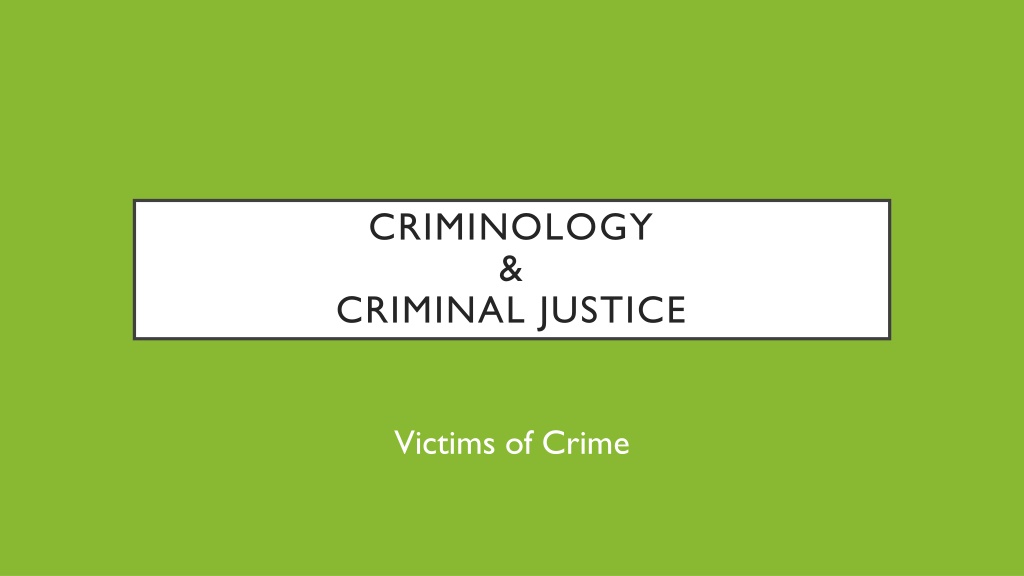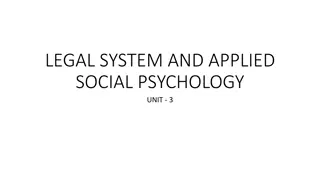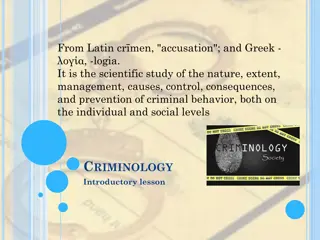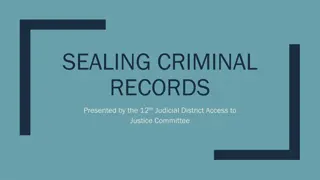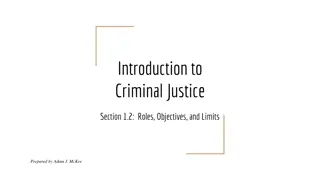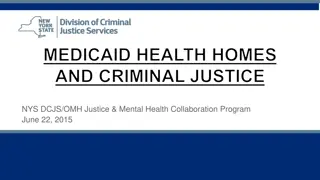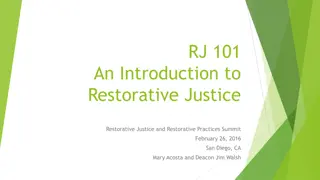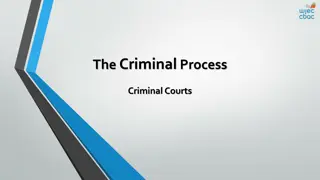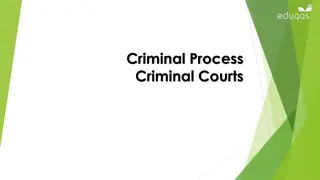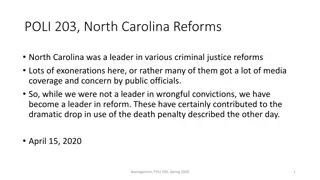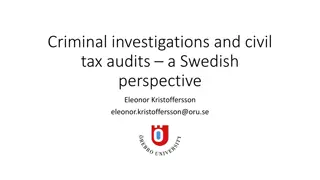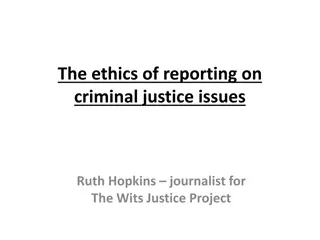CRIMINOLOGY & CRIMINAL JUSTICE
Delve into the realm of victimology, exploring the history, definitions, and importance of focusing on victims of crime. From the United Nations Declaration of Basic Principles for Victims to the Victims' Rights Act of 2002, the rights and considerations of victims and their families are examined. Discover the significance of victim-blaming, critical victimology, and the need for legislation to protect and support victims in the criminal justice system.
Download Presentation

Please find below an Image/Link to download the presentation.
The content on the website is provided AS IS for your information and personal use only. It may not be sold, licensed, or shared on other websites without obtaining consent from the author. Download presentation by click this link. If you encounter any issues during the download, it is possible that the publisher has removed the file from their server.
E N D
Presentation Transcript
CRIMINOLOGY & CRIMINAL JUSTICE Victims of Crime
Why we need to focus on victims Definitions: victim / survivor What is victimology History of victimology Positivist victimology Victim-blaming LECTURE OUTLINE Victim-blaming case studies Louise Nicholas Grace Millane Critical victimology Ideal victims Legislation in the name of victims Widening the scope of victimisation
DEFINING VICTIM Origins: a living creature sacrificed to a deity or in performance of religious rite 1985 United Nations Declaration of Basic Principles of Justice for Victims of Crime and Abuse of Power defines victims: Victims" means persons who, individually or collectively, have suffered harm, including physical or mental injury, emotional suffering, economic loss or substantial impairment of their fundamental rights, through acts or omissions that are in violation of criminal laws operative within Member States,including those laws proscribing criminal abuse of power A person may be considered a victim, under this Declaration, regardless of whether the perpetrator is identified, apprehended, prosecuted or convicted and regardless of the familial relationship between the perpetrator and the victim. The term "victim" also includes, where appropriate, the immediate family or dependants of the direct victim and persons who have suffered harm in intervening to assist victims in distress or to prevent victimization.
VICTIMS RIGHTS ACT 2002 victim (a) means (i) a person against whom an offence is committed by another person; and (ii) a person who, through, or by means of, an offence committed by another person, suffers physical injury, or loss of, or damage to, property; and (iii) a parent or legal guardian of a child, or of a young person, who falls within subparagraph (i) or subparagraph (ii), unless that parent or guardian is charged with the commission of, or convicted or found guilty of, or pleads guilty to, the offence concerned; and (iv) a member of the immediate family of a person who, as a result of an offence committed by another person, dies or is incapable, unless that member is charged with the commission of, or convicted or found guilty of, or pleads guilty to, the offence concerned
DIFFERENT LEVELS OF VICTIMS Primary: Secondary: significant others of primary victims Tertiary: directly impacted by crime rescue personnel and broader society
THE FAR REACHING IMPACTS OF VICTIMISATION It is not just primary victims who feel the impact of crime. The media ensures that even the rarest type of crime is sensationalised in such away that all observe the incident from afar. Thus, to some degree the victimisation of people we do not know or who live far away has an impact on the perceptions of society as a whole. Making victims of us all.
VICTIM OR SURVIVOR? Victim label associated with passivity and weakness People may resist this label due to the negative connotations of it Survivor : someone who continues to live or exist in spite of perils ( Oxford Dictionary , 1989). Feminist scholars explain survival as a continuum, to demonstrate the multi-dimensional and non-linear aspects of victim-survivor experiences
HISTORICAL ROLE OF VICTIMS JUDGE JUDGE VICTIM VICTIM STATE DEFENDANT DEFENDANT DEFENDANT
Victims are at the margins of criminological thought The law-abiding citizen must be at the heart of our criminal justice system. For too long it was far from the case . . . The system seemed to only think about the rights of the accused. The interests of victims appeared to be an afterthought, if considered at all. (Tony Blair, in Pratt, 2007: 136) WHY WE NEED A FOCUS ON VICTIM- SURVIVORS
VICTIMOLOGY Coined by Wertham (1949): (t)he murder victim is the forgotten man [and to] understand the psychology of the murderer we need to understand the sociology of his victim. What we need is a science of victimology (p. 259) Many strands of victimology: positivist, radical, feminist, critical Victimology has prompted the creation and extremely rapid expansion of victim support services and victim s rights legislation globally.
VON HENTIG (1948) The Criminal and his Victim (1948) He suggests that it is often the case that victims tacitly consents, co-operates, conspires or provokes their victimisation. Created 13 typologies of victims: people who are more likely to be victims
MENDELSOHN (1956) Why do some individuals [show] an inclination to sufferance (Mendelsohn, 1956, p. 4) Mendelsohn attempted to quantify the extent of the victims guilty contribution to crime: six categories from innocent to imaginary Victim and offender as a penal couple : [the delinquent s] partner, his adversary: the victim, without whose existence there is no delinquent (Mendelsohn, 1956, p. 27)
WOLFGANG (1958) Wolfgang examined police records of 588 homicides in Philadelphia between 1948 and 1952. He concluded that in 26% of occasions homicide was victim precipitated. He defined victim precipitated offences as those in which the victim is a direct, positive precipitator in the crime (Wolfgang, 1958). In short, someone who started the fight and ended up dead. Victim precipitation became an important concept in the early years of victimology as scholars sought to understand the victim-offender relationship
AMIR (1967) Amir analysed 646 rapes recorded by the Philadelphia police and concluded that 19% were victim precipitated. The term "victim precipitation" describes those rape situations in which the victim actually, or so it was deemed, agreed to sexual relations but retracted before the actual act or did not react - strongly enough when the suggestion was made by the offender(s) (Amir, 1967, p. 495) However, Amir defined precipitation in a broad and rather ambiguous manner. It included all situations where the victim, as interpreted by the offender, agreed to sexual relations. This would include: Not resisting strongly enough. Wearing provocative clothing. Drinking alcohol. Invited him into her house.
PROBLEMS OF POSITIVIST VICTIMOLOGY Data is restricted to cases known through police and the courts Many of the studies seem to be blaming victims for their own plight. victims went from being absent from the study of crime to being visible as potentially guilty suspects in crimes committed against them (Stringer, 2021, p. 307) Scientific and objective method in these studies viewed personal accounts of victimisation as untrustworthy: this further silences victim voices and experiences
VICTIM-BLAMING Victim-blaming was coined by William Ryan (1969): justifying inequality by finding defects in the victims of inequality (p. xiii) Victim-blaming tends to be directed towards victims with the least social power. It has the effect of silencing and scapegoating victims, and shifts the blame for social problems onto those most severely affected by them. (Stringer, 2021, p. 310)
CRIME PREVENTION AS THE RESPONSIBILITY OF THE VICTIM On the surface, the sign merely provides apparently logical safety precautions to help secure property. At a deeper level, the sign perfectly rehearses the key concepts of positivist victimology...[T]he sign bluntly blames the victim, who Distinguishing between ideal and guilty victims, the sign provides instructions for the ideal victim behaviour, indicating that if the instructions are not observed and a crime occurs,it will be the victim s fault...But the sign does not warn about the negative effects of economic inequality, instead narrowly framing crime as brought about by the penal couple s bad choices (Stringer,2021,p.312) encourages car theft.
CONTEMPORARY VICTIM BLAMING Louise Nicholas has claimed that three police officers pack raped her and violated her with a police baton in a Rotorua house in 1986. The accused men - Clint Rickards, at the time an Assistant Police Commissioner, and former police officers Brad Shipton and Bob Schollum - have strongly denied the allegations.
LAYING THE BLAME The main complainant, Louise Nicholas has admitted making a false allegation of abuse before. Nicholas was "lying", was a "liar", told "lies", had "lied"; by my count, he said those words 29 times. Evidence from Mrs Nicholas's flatmate at the time described a friendly atmosphere at the flat. She said she was present and also had sex with at least Shipton and Schollum. Mr Haigh said there was a "freedom of sexuality which may seem astonishing to many of us but nevertheless existed". "Walking into a lion's den in that way, walking in and knowing she was going to be raped." He also questioned why Mrs Nicholas would keep wearing for years the white muslin dress she says she was wearing on the day of the alleged Rutland St incident. "A garment worn during the most horrific experience of her life, she continues to wear it."
WHAT WAS SUPPRESSED
GRACE MILLANE What I have found most troubling during the Millane trial has been the continued focus on her sexual interests, her sexual history and her presence on dating apps and websites. The defence case, though it emphasised at the outset that Grace was not to blame, nevertheless constructed a narrative that suggested something about her, which, in turn, fed interpretations that she was somehow responsible. (Keene, 2019)
CRITICAL VICTIMOLOGY Victims voices and experiences are worthy sources of data Critical victimology explores the deeper order that produces and changes those patterns [of victimisation] and the strategies people use to survive them (Walklate, 1990, p. 39) Critiques processes of victim-blaming Explores other forms of victimisation that were previously ignored Illustrates differential treatment of victims and that our dominant cultural and social values shape who can and cannot qualify as an ideal victim .
IDEAL VICTIM Ideal victim : A person or a category of individuals who when hit by crime most readily are given the complete and legitimate status of being a victim (Christie, 1986, p. 18) Ideal victims receive a sympathetic social response Non-ideal victims : blamed and silenced The victim is ideal when the offender is ideal (Christie, 1986)
IDEAL VICTIMS IN THE MEDIA The ideal victim is a mechanism through which more punitive responses to crime and disorder are implemented. Politicians pay particular attention to ideal victims (particularly in a climate of high crime rates), since the articulation of their experiences acts as a way of pushing through a law and order agenda that metes out severe punishment to offenders (Spalek, 2006, p. 27)
NAN WITHERS AN IDEAL VICTIM Nan Withers violently attacked in 1997 and the perpetrator was sentenced to 10 years imprisonment Citizen initiated referendum (1999) which called for victim focus & harsher penalties Should there be a reform of our justice system placing greater emphasis on the needs of victims, providing restitution, and compensation for them and imposing minimum sentences and hard labour for all serious violent offences? 82.9% turnout, 91.75% in support
The dichotomy of perpetrators or victims can lead to an oversimplification of those categories. Binary categories of victim and perpetrator mean that the victimisation that a person may experience prior to harm they impose on other people is diminished or forgotten. CHALLENGING THE VICTIM- OFFENDER BINARY
